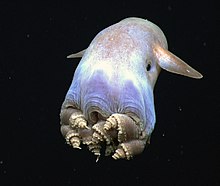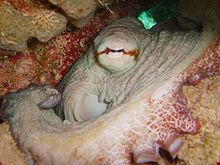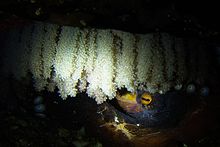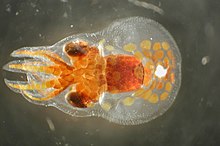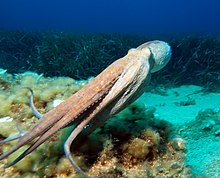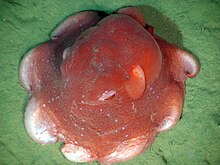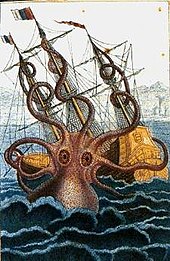Octopus
The octopods (Octopoda, from the Greek ὀκτώ oktṓ 'eight' and ‒́podo 'pie') are an order of octopodiform cephalopod molluscs commonly known as octopuses. Like other cephalopods, the octopus is bilaterally symmetrical, with its mouth and beak located at the center point of its eight limbs. Its soft body can rapidly change shape and texture, allowing the animal to squeeze through small ducts or cracks. It drags its eight appendages behind it when it swims; the siphon is used for both breathing and locomotion, expelling a stream of water. A complex nervous system and excellent eyesight make octopuses among the most intelligent and behaviorally diverse invertebrates.
Their habitats include various regions of the ocean: coral reefs, pelagic waters, and the seabed; some species live in the intertidal zone and others in the abyssal. Most species grow and mature quickly and are short-lived; They usually do not exceed two years. During reproduction, the male uses a specially adapted arm to deposit a sperm packet directly into the female's paleal cavity, after which she undergoes rapid senescence and dies a few weeks after mating. The female places the fertilized eggs in a burrow and cares for them until they hatch, and then she, too, dies. To defend themselves against predators, octopuses employ strategies such as expelling ink, camouflage, and deimatic behavior. They have the ability to speed through the water and hide, and even trick other animals. All octopuses secrete some kind of poison, although we only know that the blue-ringed octopus can be deadly.
Octopuses often appear in mythology as sea monsters: the Kraken in Norse, the Akkorokamui in Ainu, and probably the gorgon in Greek. Victor Hugo's novel The Workers of the Sea (Les Travailleurs de la mer, 1866) tells of the fight against a giant octopus, and this book has inspired other works, among them Octopussy, by Ian Fleming. Octopuses are depicted in shunga, Japanese erotic art. They are considered a delicacy in the gastronomy of many parts of the world, especially in the Mediterranean and Asian.
Anatomy and Physiology
Size
The giant octopus (Enteroctopus dofleini) is generally cited as the largest known octopus species; adults weigh around 15 kg, with arms up to 4.3 m in length. The largest individual of this species that has been scientifically documented was an animal with a live weight of 71 kg, although sizes have been claimed. much larger: there is a record of a 272 kg specimen with a 9 m arm; the carcass of a seven-armed octopus (Haliphron atlanticus ) weighed 61 kg and was estimated to have weighed live 75 kg.
The smallest species is Octopus wolfi, which measures about 2.5 cm and weighs less than 1 g.
External morphology
The octopus is bilaterally symmetric along its dorso-ventral axis, so the arms would be in an anterior position and the visceral mass in the posterior one; the head and foot are at the end of an elongated body and function as the anterior part of the animal. On the head are the eyes, a crown of appendages and the siphon; the foot has evolved into a set of flexible, prehensile appendages traditionally called arms and sometimes erroneously "tentacles", which surround the mouth and are joined together near its base by a webbed structure. described based on lateral position and sequence (such as L1, R1, L2, R2) and divided into four pairs. The two posterior appendages are generally used for walking on the sea floor, while the other six are They are used to search for food, which is why some biologists consider them to have six "arms" and two "legs". The back is formed by the mantle, quite muscular, bulbous and hollow, fused with the back of the head: it is known as the visceral mass and contains most of the vital organs. An empty cavity, the pallial cavity or mantle cavity, has muscular walls and contains the gills; it is connected to the outside by a conical funnel or siphon. The mouth, located under the arms, has a hard, sharp chitinous beak, known as a parrot's beak.
The skin is composed of a thin outer epidermis with mucous cells, sensory cells, and a connective tissue dermis consisting primarily of collagen fibers and numerous cells with pigments, such as chromatophores, that allow rapid color changes. Most of the body consists of soft tissue that allows the octopus to lengthen, contract and contort, thus being able to squeeze through small gaps; even the largest species can pass through a small opening as small as 2.5 cm in diameter. Lacking skeletal support, the arms function as muscular hydrostats, containing longitudinal, transverse, and circular muscles around an axial nerve. central. They can extend and contract, rotate to the left or right, bend at any point and in any direction, or remain rigid.
The inner face of the arms is covered with two rows of suction cups that allow it to hold onto or manipulate objects. Each sucker is typically circular and bowl-shaped; it has two differentiated parts: an external superficial cavity or infundibulum and a hollow central cavity or acetabulum; both are thick muscles covered by a protective chitinous cuticle. When a suction cup is attached to a surface, the hole between the two structures is sealed. The coordination between the muscles of the infundibulum and the acetabulum allow it to attach and detach.
The eyes, some of the most complex among invertebrates, are located on the top of the head enclosed in a cartilaginous capsule fused to the brain, are large in proportion to their body mass, and structurally similar to those of the brain. fish. The cornea, which, unlike other cephalopods, is not in contact with water, is composed of a translucent epidermal layer, and the rectangular slit-shaped pupil forms a hole in the iris and lies just behind it. The lens is suspended behind the pupil, and photoreceptor retinal cells line the back of the eye. The pupil can be adjusted in size, and a retinal pigment filters incident light in bright light conditions. They have a rigid lens and an iris that regulates the entry of light: focusing is done by moving the lens forward or backward, just like in fish.
Some species have a body shape other than the typical octopus shape. Members of the Cirrina suborder have stout gelatinous bodies with a membrane reaching near the tip of their arms and two large ear-like fins above their eyes, supported by an internal shell. The fleshy papillae or cirri that give the group its name, similar to tufts of cilia, are found along the underside of the arms. The eyes are highly developed.
Circulatory system
Octopuses have a closed circulatory system, that is, in which the blood remains inside the blood vessels. They have three hearts: a systemic heart that collects blood from the gills and circulates it throughout the body, and two branchial hearts that pump it to each of the two gills, where it is oxygenated. The systemic heart remains inactive when the animal is swimming, so it tires quickly and prefers to crawl. Your blood contains hemocyanin, a copper-rich protein, to carry oxygen, making it very viscous and requiring considerable pressure to pump it throughout your body; the blood pressure of octopuses can exceed 75 mmHg. In cold conditions with low oxygen levels, hemocyanin transports oxygen more efficiently than hemoglobin. Hemocyanin dissolves in plasma instead of being transported into blood cells and gives blood a bluish color.
The systemic heart has contractile muscular walls and consists of a ventricle and two atria, one on each side of the body. Blood vessels consist of arteries, capillaries, and veins and are lined with a cellular endothelium that is quite different from that of most invertebrates. The blood circulates through the aorta and capillary system to the vena cava, after which the blood is pumped through the gills by the auxiliary hearts and back to the main heart. Much of the venous system is contractile, which helps circulate blood.
Breathing
Respiration consists of introducing water into the paleal cavity through an opening, passing it through the gills, and expelling it through the siphon. Water entry is achieved by contraction of the radial muscles of the mantle wall; the valves of the gill fins close when strong circular muscles expel the water through the siphon. Extensive networks of connective tissue support the respiratory muscles, thus being able to expand the respiratory chamber. The lamellae structure of the gills allows a high oxygen uptake: up to 65% in water at 20 °C. The flow of water over the gills is correlated with locomotion and an octopus can propel its body when it expels water through its siphon.
Because the skin is thin, it absorbs additional oxygen. When the animal rests, about 41% of its oxygen uptake is through the skin. This percentage drops to 33% when swimming, as more water flows over the gills; oxygen uptake by the skin is also increased. When nestled in its burrow, reducing the surface area of exposed skin, and after a large meal, absorption through the skin may drop to 3% of normal.
Digestion and excretion
The digestive process begins in the buccal mass, which consists of the mouth, beak, radula, pharynx, and salivary glands. The radula is a chitinous, tongue-shaped organ with spikes; a structure of its own of the group, known as the parrot beak, consists of a pair of strong beak-like jaws that are used to bite and tear at prey for further processing by the radula. Food is broken down and directed into the esophagus through two lateral extensions of the lateral walls of the esophagus in addition to the radula; from there it is transferred to the gastrointestinal tract, which is mostly suspended from the roof of the paleal cavity by numerous membranes. The tract is composed of a dilation that functions as a crop, where food is stored; a stomach, where it decomposes; a cecum where food, now a pasty mush, breaks down into fluids and particles that play an important role in absorption; the hepatopancreas, where liver cells break down and absorb fluid; and the intestine, where the accumulated waste is converted into fecal remains by secretions and is expelled from the funnel through the rectum.
During osmoregulation, fluid is added to the pericardium of the branchial hearts. As in other mollusks, the excretory system has two nephridia (equivalent to the kidneys of vertebrates) that are related to the gill hearts; these and their associated ducts connect the pericardial cavities with the pallial cavity. Before reaching the branchial heart, each of the vena cava expands to form renal appendages that are in direct contact with the thin walls of the nephridium. Urine is first formed in the pericardial cavity and is modified by excretion, mainly of ammonia, and selective absorption from the renal appendages as it passes along the associated duct and through the nephridiopore into the pallial cavity.
Nervous system and senses
Octopuses (along with cuttlefish) have the largest and most complex brain and nervous system, as well as the highest brain-to-body-mass ratio of any invertebrate, higher even than many vertebrates. a highly complex nervous system, only part of which is located in his brain, which is contained in a cartilaginous capsule. Two-thirds of his neurons are located in the nerve cords of his arms, which display a wide variety of complex reflex actions, which they persist even when not receiving signals from the brain. The complex motor skills of octopuses, unlike vertebrates, are not organized in their brain by an internal somatotopic map of their body, but use a non-somatotopic system unique to the octopuses. large-brained invertebrates.
Their main sense organ is their eyes. Like other cephalopods, octopuses can distinguish the polarization of light. Color vision appears to vary from species to species; for example, it is present in Octopus aegina but absent in O. vulgaris. Some researchers believe that opsins in the skin can detect different wavelengths of light and help them choose a camouflage coloration, in addition to the light perception of the eyes. Others hypothesize that that cephalopod eyes in species that have a single photoreceptor protein can use chromatic aberration to convert monochromatic vision to color vision, even if this means sacrificing image quality; W or dumbbell, plus the need for colorful mating displays.
Next to the brain are two special organs called statocysts (sac-like structures containing a mineralized mass and sensitive hairs) that provide it with information about changes in the body's position relative to gravity and can detect angular acceleration, although not spatial orientation continuously. An autonomic response keeps the octopus's eyes oriented so that the pupil is always horizontal. They can also use the statocyst to pick up sounds; the common octopus can hear sounds between 400 Hz and 1,000 Hz, although it perceives them best at 600 Hz.
On the other hand, they have an excellent sense of touch. The suckers are equipped with chemoreceptors so that the octopus can taste what it touches. The arms do not get tangled or stuck together because the sensors distinguish their own skin from that of other octopuses and prevent self-gluing.
The arms contain tension sensors so that they know if they are stretched, although this is not enough for the brain to determine the position of the body or the arms, for this reason the octopus does not have stereognosis capacity, that is, it does not form a mental image of the volume and general shape of the object you are handling without seeing it. It can detect local texture variations, but it can't integrate the information into a larger image. The neurological autonomy of the arms means that they have great difficulty learning about the detailed effects of their movements. He has a poor proprioceptive sense and knows what exact movements were made only by visually perceiving the arms (exteroception).
Ink Sac
The rectal gland of these mollusks has been transformed into an ink gland that produces a secretion stored in a sac below the digestive gland. The sac is close enough to the siphon that the octopus expels the ink with a stream of water. Before it leaves the siphon, the ink passes through glands that mix it with a mucous substance, creating a thick, dark stain that helps the animal escape a predator. The main pigment in the ink is melanin, which gives it its black color. Members of the Cirrina suborder lack an ink sac.
Life Cycle
Playback
All cephalopods are gonochoric; octopuses have a single gonad located at the rear of the visceral mass and associated with the coelom. Males have a testis and a coiled vas deferens that carry sperm to a seminal vesicle where they are encapsulated in spermatophores; females have an ovary and an oviduct with an oviductal gland. A spherical optic gland associated with the optic pathways generates hormones that mature the octopus and stimulate gamete production; this gland can be activated by environmental conditions such as temperature, light, and nutrition, thus controlling the timing of reproduction and the length of life.
Octopuses, like other cephalopods, are promiscuous. In the adult stage they show clear sexual dimorphism; in males (smaller than females) one of the arms becomes a hectocotylus in its final section, which acts as a copulatory organ; during copulation, the male, using the hectocotyled arm, with its spoon-shaped end, the ligule, introduces spermatophores into the female's paleal cavity that will later release the spermatozoa. The hectocotylus in benthic octopuses is generally the third arm, which has a spoon-shaped depression, the ligule, at the tip, and modified suckers. In most species, fertilization occurs in the mantle cavity.
Their reproduction has been studied in only a few species; one of them is the giant octopus (Enteroctopus dofleini), in which courtship is accompanied, especially in the male, by changes in the texture and color of the skin. The male may cling to the top or side of the female or position himself next to her. There is speculation as to whether he can first use his hectocotylus to remove any spermatophore or sperm already present in the female. He picks up a spermatophore from his sperm sac with the hectocotyl, inserts it into the female's mantle cavity, and deposits it in the proper place for the species, which in the giant octopus is the oviductal opening. He transfers to her two spermatophores, about a meter long, the ends of which can protrude from the female's mantle.A complex hydraulic mechanism releases the spermatozoa from the spermatophore and the female stores them internally.
About forty days after mating, the female giant octopus attaches strings or cords of small fertilized eggs (10,000 to 70,000) by one end to rocks in a crevice or under an overhang in clusters. There she protects and cares for them for about five months (160 days) until they hatch.In colder waters, such as those off Alaska, it can take up to 10 months for the eggs to fully develop.The female aerates the eggs and keeps them clean; if left unattended, many eggs will fail to hatch. The female does not feed during this time and dies soon after. Males undergo rapid senescence and die a few weeks after mating.
Eggs have large yolks; embryonic segmentation (division) is superficial and a germinal disc develops at the pole. During gastrulation, the margins of the disc grow and surround the yolk, forming a yolk sac, which will become part of the intestine. The yolk is gradually absorbed as the embryo develops. When the embryo reaches the appropriate size and the yolk sac has been almost completely consumed, hatching occurs.
Most octopuses hatch as paralarvae and are planktonic for weeks to months, depending on the species and water temperature. They feed on copepods, arthropod larvae, and other zooplankton, eventually settling on the ocean floor and developing directly into adults, without metamorphosis with distinct larval stages, unlike other molluscs. Octopus species that spawn larger eggs, such as Octopus briareus, Hapalochlaena maculosa, Octopus bimaculoides, Eledone moschata and deep-sea octopuses, do not have a paralarval stage, but are born as benthic animals morphologically similar to adults.
The female argonaut secretes a thin, ribbed, paper-thin shell in which she lays her eggs and also resides in while floating in mid-ocean. She there she raises the juveniles and also serves as a flotation aid that allows her to adjust her depth. The male is diminutive in comparison and has no shell.
Life expectancy
Most species have a relatively short lifespan; some species live as little as six months, although the giant octopus (Enteroctopus dofleini), one of the largest species, can live up to five years.
Octopus lifespans are limited by reproduction: males can only live for a few months after mating, and females die shortly after their eggs hatch. Its reproductive organs mature under the hormonal influence of the optic gland but cause inactivation of its digestive glands, which usually causes the octopus to starve. Removal of the optic glands after spawning has been shown to result in cessation of spawning. care of the eggs, feeding is resumed, and with it growth increases, prolonging the duration of life.
Distribution and habitat
Octopuses live in all oceans, and different species have adapted to different marine habitats. As juveniles, common octopuses (Octopus vulgaris) inhabit shallow tide pools; the great blue octopus (Octopus cyanea) lives in coral reefs; the argonauts drift through pelagic waters; Abdopus aculeatus lives mainly in nearshore seagrass beds.
Some species have adapted to the cold waters of the deep ocean; Bathypolypus arcticus lives on abyssal plains at depths of 1,000 m and Vulcanoctopus hydrothermalis lives near hydrothermal vents at 2,000 m. Species of the Cirrina suborder are often free-swimming and live in deep-sea habitats. No species known to live in freshwater.
Behavior and ecology
Octopuses are generally considered solitary animals, not very social, although this consideration is faced with a growing number of exceptions; there is also evidence of concentrations in large numbers and with frequent interactions, defense of the pair and expulsion of individuals from dens, although this is probably due to an especially abundant food supply combined with areas where dens are scarce. Octopuses hide in burrows, which are usually crevices in rock outcroppings or other hard structures, although some species bury themselves in sand or mud. They are not territorial, but generally remain in a specific area; They may leave that area in search of food. They have navigational abilities that allow them to return to a lair without taking the same route they used when they left. They are not known to be migratory.
They carry captured prey to their den where they can safely eat. Sometimes they manage to catch more prey than they are capable of eating and the den is often surrounded by a dump of dead prey and remains. Other creatures, such as fish, crabs, echinoderms, or other mollusks, often share the burrow with the octopus, either because they have arrived as scavengers or because they have survived capture.
Food
Almost all octopods are predators; the species that live on the seabed feed mainly on crustaceans, polychaete worms and other molluscs, such as snails and clams; those from the open sea eat mainly prawns, fish and other cephalopods. The main component of the giant octopus's diet is bivalve molluscs: the cockle Clinocardium nuttallii, clams and scallops, crustaceans such as crabs and spider crabs. There are prey that are not within their reach: naticids, because they are too big, and barnacles, scallops, chitons or abalone, because they are too attached to the rocks.
Benthos octopuses (which live at the bottom of the sea) generally move between rocks; they locate prey by groping between crevices or thanks to their magnificent vision; Driven by a jet of water emitted by their siphon, they jump on their prey and pull it towards their mouths with their arms, holding it with the suction cups. Small prey can be completely ensnared by the webbed structure between their arms. Octopuses often inject crabs and other crustaceans with paralyzing saliva and then dismember them with their beaks. They feed on shelled mollusks by prying the valves apart or drilling a hole in the shell to inject a neurotoxin. It was believed that the hole was pierced with the radula, but it has been shown that they have tiny teeth at the tip of the salivary papilla and use an enzyme from their toxic saliva to dissolve calcium carbonate in the shell. The common octopus (O. vulgaris) takes approximately three hours to create a 0.6 mm hole. Once the shell is penetrated, the prey dies almost instantly, its muscles relaxing, and the soft tissues easy to remove. They can also use the same system with hard-shelled crabs, because soft-shelled ones get torn apart.
Some species have other ways of feeding. Grimpoteuthis has no or greatly reduced radula and swallows prey whole. In most species of the deep-sea genus Stauroteuthis, some of the muscle cells that Controlling the suction cups have been replaced by photophores which are believed to trick prey by directing it towards the mouth, making them one of the few bioluminescent octopuses.
Locomotion
Jet propulsion, or backward swimming, is their fastest means of locomotion. When not in a hurry, they generally crawl on solid or soft surfaces; they extend several arms forward, some of the suckers adhere to the substratum and the animal drags itself forward, propelling itself with its powerful muscular arms, while with the other arms it pushes backwards. While crawling, the heart rate almost doubles, and it takes the animal ten to fifteen minutes to recover from relatively minor exertion.
Jet propulsion is achieved thanks to the contraction of the muscular layers of the mantle, rapidly emptying its paleal cavity of water, expelling it through the siphon, propelling the octopus in the opposite direction. The direction of displacement depends on the orientation of the siphon. When swimming, the head is in the front, the siphon points to the rear, and the arms trail behind, giving the animal a fusiform appearance. In an alternative method of swimming, some species flatten dorsoventrally and swim with their arms extended to the sides, which can provide lift and be faster than normal swimming. The jet is used to escape danger, but it is physiologically inefficient and requires such high mantle pressure that it prevents the heart from beating, causing progressive oxygen deficit.
Cirrine octopuses cannot produce jet propulsion and use their flippers to swim. They have neutral buoyancy and move through the water with their fins extended. They can also contract their arms and the surrounding membrane in rapid movements to propel themselves. Another form of locomotion is "pumping", which consists of symmetric contractions of the muscles of the membranes producing peristaltic waves, which produces a slow movement of the animal.
In 2005 it was observed that two species, Adopus aculeatus and Amphioctopus marginatus, moved by walking on two arms, while at the same time imitating the coloration of plant matter surrounding; this form of locomotion would allow these octopuses to quickly move away from a potential predator without being recognized. A study of this behavior led to consideration of the possibility that the two posterior appendages could be more accurately referred to as "legs" rather than "arms". Amphioctopus marginatus uses this "bipedal" movement when carrying several stacked coconut husks; the octopus carries remnants of shell under it with two arms and moves with an ungainly gait supported by its remaining arms which it holds rigid.
Some species of can crawl out of the water for short periods of time between tide pools while hunting for crustaceans or gastropods or to escape predators.
Intelligence
Octopuses are considered to be among the most intelligent and behaviorally diverse invertebrates, though the extent of their intelligence and learning ability are still not well defined. Maze-solving and experiments of problems have shown evidence of a memory system that can store both short-term and long-term memory. It is not known precisely what learning contributes to the behavior of the adult octopus. Young octopuses do not learn from their parents, as adults provide no parental care beyond tending to their eggs until they hatch.
In laboratory experiments, octopuses can be easily trained to distinguish between different shapes and patterns. There are reports that they engage in observational learning, although the validity of these reports is questioned. They have also been observed in what has been described as play: repeatedly dropping bottles or toys in a circular current in their aquariums and then catch them. They often manage to get out of their aquariums and sometimes enter others in search of food. They have even boarded fishing boats and opened holds to eat crabs. Amphioctopus marginatus collects remains of coconut shells and then uses them to build a shelter, an example of tool use.
In 2021, a scientific report from the London School of Economics established that cephalopods and crustaceans (such as octopuses, crabs, and lobsters) are sentient beings that experience pain and distress, as well as pleasure or joy. For this reason, the British government decided to include them in its Animal Welfare Bill to protect them from certain painful practices.
Camouflage
Octopuses use camouflage when hunting and to avoid being seen by predators. The outer part of the mantle is made up of an epithelium with numerous specialized cells, such as chromatophores and photophores, that rapidly change the appearance of the skin by adjusting its color, opacity, or reflectivity. Chromatophores contain yellow, orange, red, brown, or black pigments; most species have three of these colors, while others have two or four. Other reflective cells are iridophores (iridescent) and leucophores (white in color). This color-changing ability is also used to communicate or warn other octopuses.
They can create distracting patterns with wavy lines of dark coloration all over their bodies. Muscles in the skin change the texture of the coat for greater camouflage. In some species, the mantle can take on the appearance of algae; in others, the appearance of the skin is limited to relatively uniform shades of a single color with a smooth skin texture. Diurnal species living in shallow water have developed more complex skin than nocturnal and deep-sea species.
A "moving rock" strategy involves imitating the appearance of a rock and inching across an open space at a speed that matches the movement of the surrounding water, allowing you to move even in full view of a predator.
Defense
In addition to humans, octopuses have multiple predators, including fish, seabirds, pinnipeds, cetaceans, sea otters, and other cephalopods. Octopuses generally hide in dens or conceal themselves using camouflage and mimicry; some use conspicuous warning coloration (aposematism) or deimatic displays. An octopus can spend 40% of its time hiding in its den. In a study with giant octopus (Enteroctopus dofleini) it was found that 66% of the specimens studied had scars and 50% had amputated arms. Hapalochlaena lunulata, one of the most venomous animals in the world, it has blue rings hidden in the muscular folds of the skin but it shows them when the animal feels threatened, offering an iridescent warning of the danger of its venom. The pulpon (Otoctopus macropus) becomes bright brownish-red with very conspicuous oval white spots. Visual cue displays are often reinforced by extending the arms, fins, or webbed structure between the arms to make them look as large and threatening as possible. as possible.
When they see a predator they usually try to escape but can also use a distraction by ejecting a cloud of ink from the ink sac. The ink is believed to reduce the effectiveness of the olfactory organs, which would help them evade predators that use smell to hunt, such as sharks. The ink clouds of some species can act as lures that the predator attacks instead.
When attacked, some octopuses can detach an arm to escape, similar to the way skinks and other lizards split their tails; the detached arm can distract potential predators. These severed arms remain sensitive to stimuli and withdraw from unpleasant sensations. Octopuses can regenerate lost limbs.
Some species, such as the mimic octopus (Thaumoctopus mimicus), can combine their highly flexible bodies with their ability to change color to imitate other more dangerous animals, such as lionfish, snakes marinas and eels.
Pathogens and parasites
Diseases and parasites that affect octopuses have been little studied, but it is known that cephalopods are the intermediate or final hosts of various cestodes, nematodes, and copepods; 150 species of protist and metazoan parasites have been recognized. Dicyemidae are a family of small worms found in the renal appendages of many species; whether they are parasitic or endosymbiont is unclear. Coccidiasins of the genus Aggregata living in the intestine cause severe disease in the host. Octopuses have an innate immune system, and hemocytes respond to infection by phagocytosis, encapsulation, infiltration, or cytotoxic activities to destroy or isolate pathogens; Hemocytes play an important role in the recognition and removal of foreign bodies and wound repair. Captive octopuses have been shown to be more susceptible to pathogens than wild ones. A gram-negative bacterium, Vibrio lentus, has been found to cause skin lesions, muscle exposure, and even death in extreme cases..
Evolution
Fossil record and phylogeny
Cephalopods have existed for 500 Ma, and the ancestors of octopods were present in Carboniferous seas as early as 300 Ma. The oldest known octopus fossil is Pohlsepia, which lived 296 years ago. Ma. Researchers have identified impressions of eight arms, two eyes, and possibly an ink sac. Octopuses are mostly soft tissue, so fossils are relatively rare. Octopuses, squids, and cuttlefish belong to the Coleoidea clade. They are known as "soft-bodied" cephalopods because they lack the outer shell of most molluscs and other cephalopods such as nautiloids and the extinct ammonites. Octopuses have eight limbs like other coleoids, but lack specialized feeding appendages. additional, known as tentacles, which are longer and thinner with suckers only at the ends. The vampire squid (Vampyroteuthis infernalis) also lacks tentacles but has sensory filaments.
The following are cladograms of two possible phylogenies of extant cephalopods, based on the genetic studies of Strugnell et al. (2007):
- Class 1
| Cephalopods |
| ||||||||||||||||||
- Class 2
| Cephalopods |
| ||||||||||||||||||
Taxonomy
The scientific name Octopoda was coined and classified as an order of octopuses in 1818 by English biologist William Elford Leach, who classified them as Octopoida the previous year. Octopoda consists of around 300 known species and is divided into into two suborders, Incirrina and Cirrina. Incirrhines (most species) lack swimming fins and the cirri on the suckers of cirrini.
- Order Octopoda
- GenderKeuppia (incertae sedis)
- GenderPalaeoctopus (inc. sed.)
- GenderPaleocirroteuthis (inc. sed.)
- GenderPohlsepia (inc. sed.)
- GenderProteroctopus (inc. sed.)
- GenderStyletoctopus (inc. sed.)
- Suborden Cirrina: octopus with deep water fins
- Family Opisthoteuthidae: Paraguayan octopus
- Cirroctopodidae
- Family Cirroteuthidae
- Family Stauroteuthidae
- Suborden Incirrine
- Superfamily Octopodoida
- Family Amphitretidae
- Family Bathypolypodidae
- Eledonidae Family
- Enteroctopodidae
- Family Megaleledonidae Taki, 1961
- Octopodidae family
- Superfamily Argonautoidea
- Alloposidae family: seven-armed octopus
- Argonautidae family: argonauts
- Ocythoidae family: tuberculated pelagic octopus
- Tremoctopodidae family: octopus manta
- Superfamily Octopodoida
Relationship with humans
Cultural References
Octopuses were known to sailors in ancient times, as evidenced by some artwork and drawings. For example, a stone carving found at a Bronze Age archaeological site of the Minoan civilization at Knossos (1900-1100 BC) shows a representation of a fisherman carrying an octopus. The powerful gorgon of Greek mythology was inspired by the octopus or squid, the octopus itself looks like the typical representation of Medusa's severed head: beak like tongue and protruding fangs and arms like snakes. Kraken is a legendary sea monster of gigantic proportions said to inhabit the coasts of Norway and Greenland, generally depicted in art as a giant octopus that attacks ships. Linnaeus included it in the first edition of his Systema naturæ in 1735. A Hawaiian creation myth says that the present cosmos is the last in a series that arose in stages from the ruins of the earlier universe; in this depiction, the octopus is the only survivor from the previous universe. Akkorokamui is a gigantic octopus-like monster from Ainu folklore.
In Victor Hugo's novel The Workers of the Sea (Les Travailleurs de la mer, 1866), a book dedicated to the island of Guernsey, where Hugo stayed for 15 years exiled, the fight against a giant octopus is recounted. Ian Fleming's collection of short stories Octopussy (1966) and the 1983 James Bond film were partly inspired by Hugo's book.
Shunga, a genre of Japanese erotic art, includes ukiyo-e woodblock prints such as Katsushika Hokusai's 1814 Dream of the Fisherman's Wife (蛸と海女, tako to ama?, The Octopuses and the Diver), in which a love has sexual relations with a large and a small octopus. This print is a precursor to the theme known as tentacle eroticism. American biologist PZ Myers noted in his science blog, Pharyngula, that octopuses appear in "extraordinary" graphic illustrations with women, tentacles and bare breasts.
Because it has numerous arms emanating from a common center, the octopus is sometimes used as a symbol of a powerful and manipulative organization, usually in a negative way.
Dangerousness
All species produce some form of venom, but only blue-ringed octopuses (genus Hapalochlaena) have venom that can be fatal to humans. There are reports of bites every year in the range of this species, from Australia to the eastern Indo-Pacific. They sting only when provoked or accidentally stepped on; the bites themselves are small and usually painless. The poison seems to be able to penetrate the skin without punctures, just by contact; contains tetrodotoxin, a neurotoxin that causes paralysis by blocking the transmission of nerve impulses to the muscles and causes death from respiratory failure leading to cerebral anoxia. These bites are very dangerous and there is no known antidote, but if prompt professional medical attention is received, patients generally recover. There are reports of bites from other octopus species, generally in captivity, causing swelling and discomfort that they disappear in a day or two.
Fishing and gastronomy
Octopus fisheries exist worldwide, with total catches varying between 245,320 and 322,999 tonnes between 1986 and 1995. The global catch peaked in 2007 at 380,000 tonnes and declined to about 336,000 in 2012. For their capture, pots, trawls, traps, drift nets, harpoons, hooks and capture by hand are used.
Octopus is part of the gastronomy of many cultures and is a common food along the Mediterranean and Asian coasts. The arms and, to a lesser extent, other parts of the body are cooked in different ways, depending on the species or the local custom. In some countries around the world, such as the United States, there are restaurants where they are eaten alive; animal welfare groups have opposed this practice on the grounds that octopuses can experience pain.
Science and technology
In classical Greece, Aristotle (384-322 BC) already spoke in his History of Animals about the ability of the octopus to change color, both for camouflage and for concealment. signaling: «The octopus... looks for its prey by changing its color so that it acquires the color of the adjacent stones; it also does so when alarmed." Aristotle also indicated that the octopus had a hectocotylated arm and suggested that it could be used in sexual reproduction, a claim that was widely rejected until the XIX. It was described in 1829 by the French zoologist Georges Cuvier, who assumed it to be a parasitic worm, classifying it as a new species, Hectocotylus octopodis. Other zoologists believed it to be a spermatophore; the German zoologist Heinrich Müller believed that it was "designed" to separate during copulation. In 1856, the Danish zoologist Japetus Steenstrup showed that it is used to transfer sperm and is rarely shed.
Octopuses are used as model organisms in many fields of biological research, such as their ability to regenerate limbs, change their skin color, behave intelligently with a distributed nervous system, or use 168 types of protocadherins (humans have 58), the proteins that guide the connections neurons make with each other.
The genome of Octopus bimaculoides (the first cephalopod whose genome was sequenced) has been sequenced, which will allow the study of its molecular adaptations. an intelligence similar to that of mammals. Their problem-solving abilities, along with their mobility and lack of rigid frame allow them to escape supposedly safe tanks in laboratories and aquariums.
Due to their intelligence, in some countries octopuses are not used as experimental animals when surgery can only be performed without anesthesia, a protection that generally only applies to vertebrates. In the UK, from 1993 to 2012, the common octopus (Octopus vulgaris) was the only invertebrate protected under the Animals (Scientific Procedures) Act 1986. In 2012 this legislation was extended to include to all cephalopods, in accordance with a general directive of the European Union.
Some robotics research explores biomimicry of some of the octopus's characteristics. Its arms can largely move and feel autonomously without intervention from the animal's central nervous system. In 2015, a team of researchers in Italy built soft-bodied robots capable of crawling and swimming that required only minimal computing. In 2017, a German company made an arm with a pneumatically controlled soft silicone frame equipped with two rows of suction cups; He is able to grasp objects such as a metal tube, a magazine, or a ball, and to fill a glass by pouring water from a bottle.
Additional bibliography
- Roper, C. F. E.; Sweeney, M. J.; Hochberg, F. G. (1995). «Cefalopods». In Fischer, W.; Krupp, F.; Schneider, W.; Sommer, C.; Carpenter, K. E.; Niem, V.H., eds. FAO guide for the identification of species for fishing purposes. Pacifico Centro-Oriental 1. FAO. pp. 306-353. ISBN 92-5-303408-4.
- López Peraza, D. J. (2009). Histological description of gonadal maturity stages in octopuses Octupus bimaculoides and Octupus rubescens (thesis of Master's in Sciences). Centro de Investigación Científica y de Educación Superior de Ensenada, Baja California.
Contenido relacionado
Beekeeping
Hominoid
Mushroom



